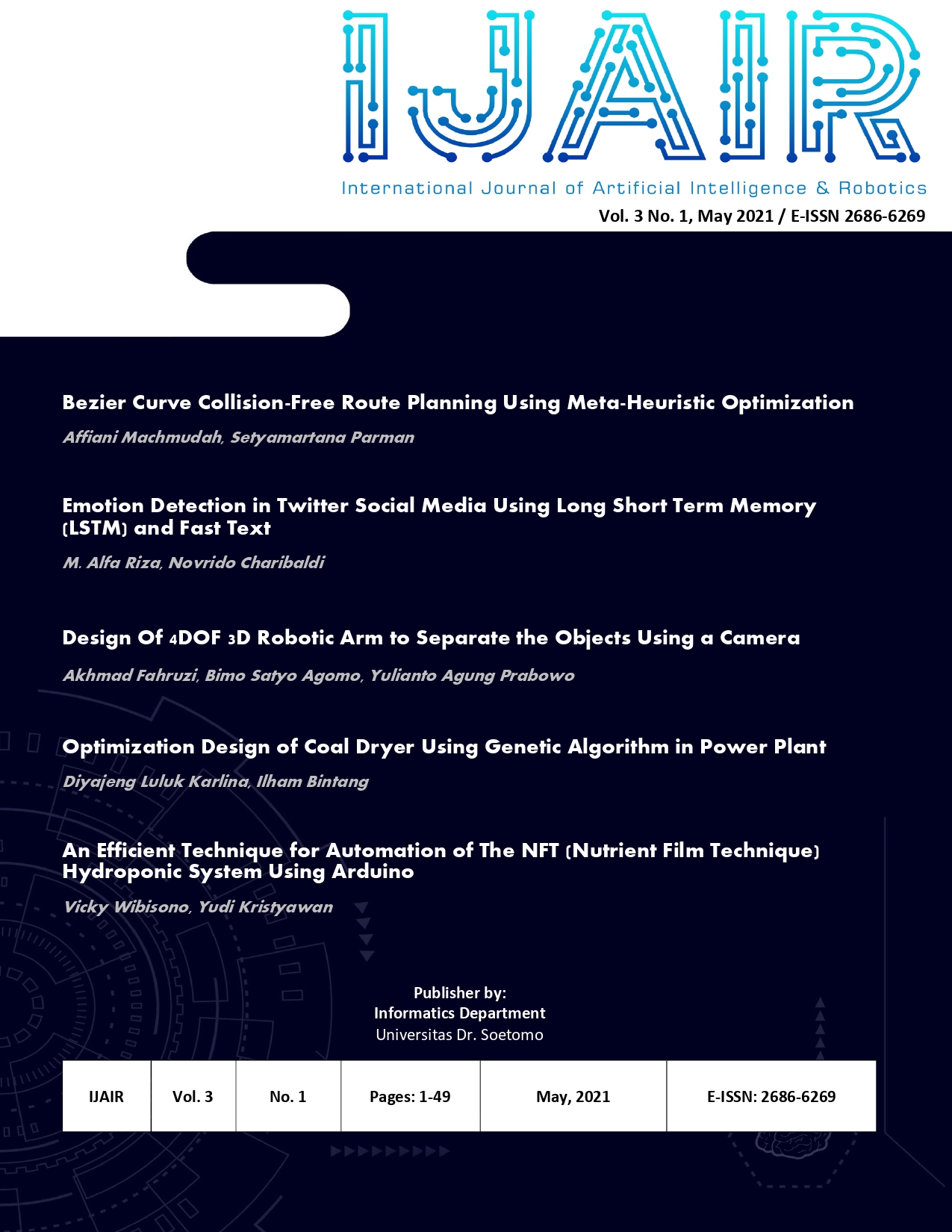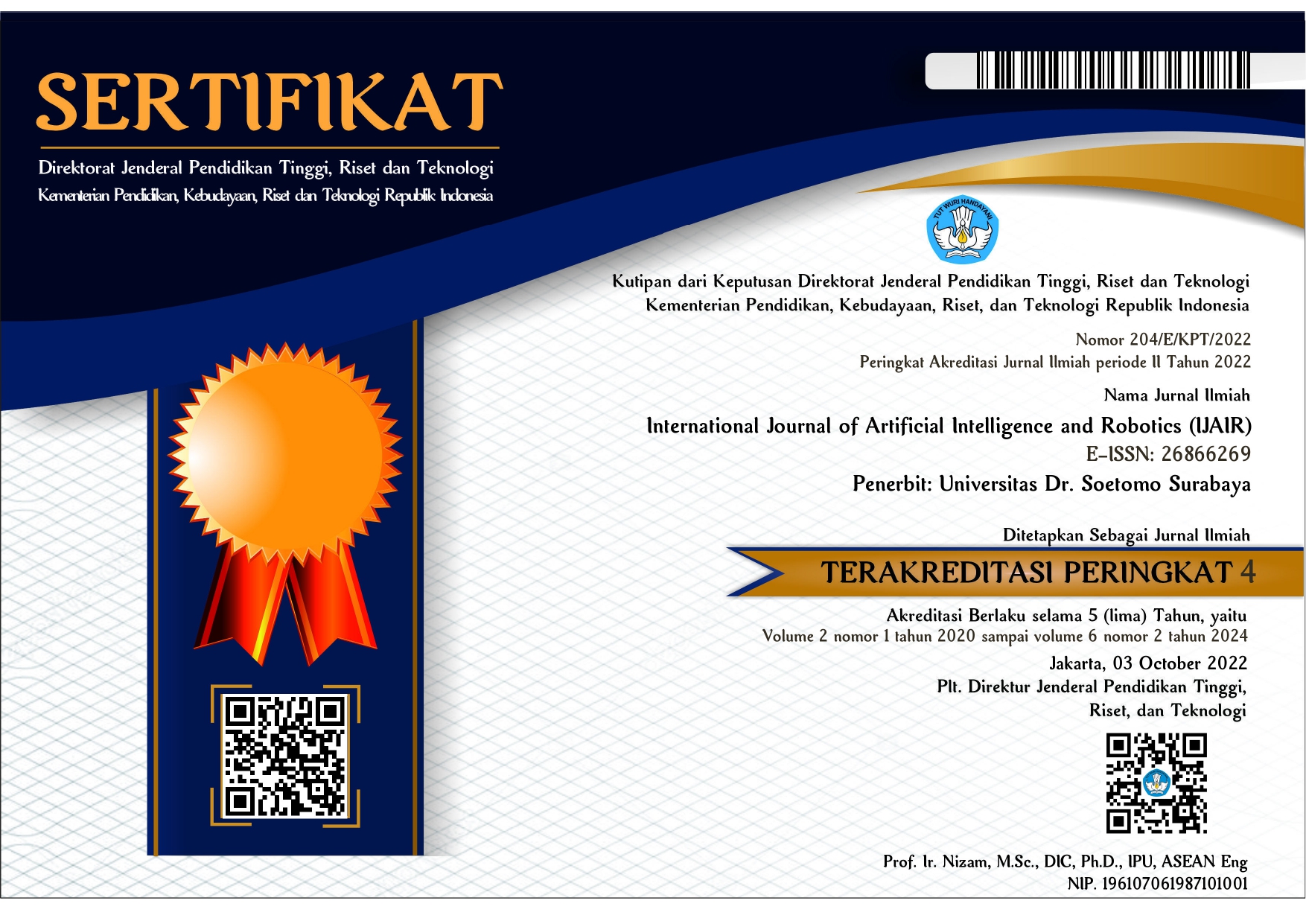Bezier Curve Collision-Free Route Planning Using Meta-Heuristic Optimization
 Abstract views: 346
,
Abstract views: 346
,
 PDF downloads: 278
PDF downloads: 278
Abstract
A collision-free route is very important for achieving sustainability in a manufacturing process and vehicle robot trajectories that commonly operate in a hazardous environment surrounded by obstacles. This paper presents a collision avoidance algorithm using a Bezier curve as a route path. The route planning is modeled as an optimization problem with the objective optimization is to minimize the route length considering an avoiding collision constraint. The collision-avoidance algorithm based on curve point analysis is developed incorporating metaheuristic optimizations, namely a Genetic Algorithm (GA) and a Grey Wolf Optimizer (GWO). In the collision avoidance algorithm, checking of curve point's position is important to evaluate the individual fitness value. The curve points are analyzed in such a way so that only the paths which are outside the obstacle area are selected. In this case, besides the minimum length as a fitness function, the constraint is the position of curve points from an obstacle. With the help of meta-heuristic optimization, the developed collision avoidance algorithm has been applied successfully to different types of obstacle geometries. The optimization problem is converted to the maximization problem so that the highest fitness value is used to measure the performance of the GA and GWO. In general, results show that the GWO outperforms the GA, where it exhibits the highest fitness value. However, the GA has shown better performance for the narrow passage problem than that of the GWO. Thus, for future research, implementing the hybrid technique combining the GA and the GWO to solve the advanced path planning is essential.
Downloads
References
J. Jiang, Y. Ma Y, “Path planning strategies to optimize accuracy, quality, build time and material use in additive manufacturing: a review,” Micromachines, vol. 11, no. 7, pp. 633, 2020
H. Giberti, L. Sbaglia, M. Urgo, “A path planning algorithm for industrial processes under velocity constraints with an application to additive manufacturing,” J. Manuf. Syst., vol. 43, pp. 160–167, April 2017
L. Wang, “Collaborative robot monitoring and control for enhanced sustainability,” Int. J. Adv. Manuf. Technol., vol. 81, no. 9, pp.1433–1445, Dec. 2015
M. Zhang, A. Filippone, N. Bojdo, “Multi-objective optimisation of aircraft departure trajectories,” Aerosp. Sci. Technol., vol. 79, pp. 37–47, Aug. 2018
M. Gil, J. Montewka, P. Krata, T. Hinz, S. Hirdaris, “Determination of the dynamic critical maneuvering area in an encounter between two vessels: Operation with negligible environmental disruption,” Ocean Eng., vol. 213, Oct. 2020
M. Garetti, M. Taisch M, (2012) “Sustainable manufacturing: trends and research challenges,” Prod. Plan Control, vol. 23, no, (2-3), 2019, pp. 83–104
R. A. Saeed, D. R. Recupero, P. Remagnino, (2020) “A boundary node method for path planning of mobile robots,” Robot. Auton. Syst., vol. 123, pp. 03320, Jan. 2020
R. Kala, A. Shukla, R. Tiwari, “Robotic path planning in static environment using hierarchical multi-neuron heuristic search and probability based fitness,” Neurocomputing, vol. no. 74 (14–15), pp. 2314-2335, July 2011
Y. Linquan, L. Zhongwen, T. Zhonghua, Lv Weixian, “Path planning Algorithm for Mobile Robot Obstacle Avoidance Adopting Bezier Curve Based on GA,” in Proc. 2008 Chinese Control and Decision Conference (CCDC 2008), pp. 3286-3289, doi: 10.1109/CCDC.2008.4597937
J. Choi, G. H. Elkaim, “Smoth Path Generation Based on Bezier Curves for Autonomous Vehicle,” in Proc. World Congress on Engineering and Computer Science (WCECS), 2009, ISBN: 978-988-98671-0-2.
Z. Lil, D.S. Meek, D.J. Walton, “A smooth, obstacle-avoiding curve”, Comput. Graph., Vol. 30, pp. 581–587, Aug. 2006
S.N. Sivanandam, S.N. Deepa, Introduction to Genetic Algorithm, Spinger-Verlag, 2008
S. Mirjalili, S. M. Mirjalili, A. Lewis, “Grey wolf optimizer,” Adv. Eng. Softw., vol. 69, pp. 46–61, March. 2014
J. M. Lien, J. Keyser, N. M. Amato NM, (2006) “Simultaneous shape decomposition and skeletonization,” in ACM symposium on solid and physical modeling, 2006, pp 219–228
V. Vonásek, R. Pěnička, B. Kozlíková, “Searching Multiple Approximate Solutions in Configuration Space to Guide Sampling-Based Motion Planning,” J Intell Robot Syst, vol. 100, pp. 1527–1543, Aug. 2020
A. Varava, J. F. Carvalho, F. T. Pokorny, D. Kragic, “Free space of rigid objects: Caging, path non-existence, and narrow passage detection. In Workshop on algorithmic foundations of robotics, 2018, pp. 19-35
E. J. Griffith, C. Mishra, J. F. Ralph and S. Maskell, "A system for the generation of synthetic Wide Area Aerial surveillance imagery", Simulation Modelling Practice and Theory, vol. 84, pp. 286-308, 2018.
C. Yuan, H. Cai, “Spatial reasoning mechanism to enable automated adaptive trajectory planning in ground penetrating radar survey,” Autom. Constr., vol. 114, pp. 103157, 2020
A.L. Alfeo, M.G. Cimino, G. Vaglini, “Enhancing biologically inspired swarm behavior: Metaheuristics to foster the optimization of UAVS coordination in target search,” Computers & Operations Research, vol. 110, pp. 34-47, 2019
Zimmermann M., Frejinger E., “A tutorial on recursive models for analyzing and predicting path choice behavior,” EURO Journal on Transportation and Logistics, vol. 9, pp. 100004, 2020
B. I. Kazem, A. I. Mahdi, A. T. Oudah, "Motion Planning for a Robot Arm by Using Genetic Algorithm", Jordan Journal of Mechanical and Industrial Engineering, vol. 2, no. 3, pp. 131-136, 2008.
P. Corke, Robotics, Vision and Control: Fundamental Algorithms In MATLAB, Berlin: Springer, 2017
M. Shanmugavel, A. Tsourdos, B. A. White, R. Zbikowski, “Differential Geometric Path Planning of Multiple UAVs,” ASME Journal, Vol. 129, No. 11, pp. 620-632, 2007.
M. Shanmugavel, A. Tsourdos, B. A. White, R. Zbikowski, “Co-operative Path Planning of Multiple UAVs using Dubins Paths with Clothoid arcs” Control Engineering Practice, Vol. 18, pp. 1084-1092, 2010.
Copyright (c) 2021 Affiani Machmudah, Setyamartana Parman

This work is licensed under a Creative Commons Attribution-ShareAlike 4.0 International License.
Authors who publish with International Journal of Artificial Intelligence & Robotics (IJAIR) agree to the following terms:
-
Authors retain copyright and grant the journal right of first publication with the work simultaneously licensed under a Creative Commons Attribution License (CC BY-SA 4.0) that allows others to share the work with an acknowledgment of the work's authorship and initial publication in this journal.
-
Authors are able to enter into separate, additional contractual arrangements for the non-exclusive distribution of the journal's published version of the work (e.g., post it to an institutional repository or publish it in a book), with an acknowledgment of its initial publication in this journal.
-
Authors are permitted and encouraged to post their work online (e.g., in institutional repositories or on their website) prior to and during the submission process, as it can lead to productive exchanges, as well as earlier and greater citation of published work.















